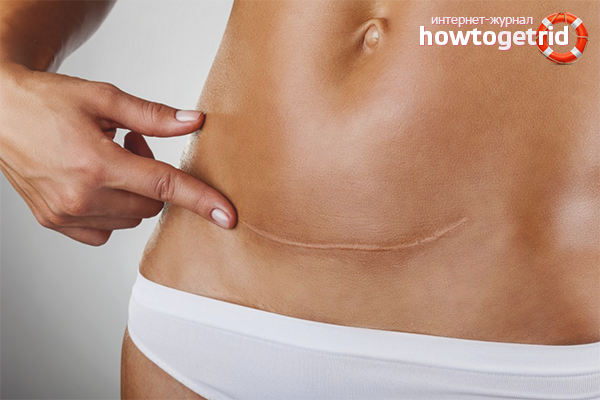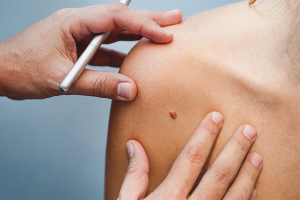The content of the article
Scars can appear not only as a result of surgical intervention, but also due to ordinary injuries: cuts, burns; however, postoperative scars are usually the largest in size and dense. They look the least aesthetically pleasing, and getting rid of them is the most difficult, despite the fact that now there are many cosmetics. And in extreme cases, you can always contact a plastic surgeon who will correct any skin imperfections.
Scars: what they are
Even the scars from operations can turn out different: everything depends on what kind of surgical intervention was, how skillfully the surgeon worked, what tools he used, and, of course, on the individual characteristics of the body.
- After operations performed directly on the surface of the skin (for example, removal of hemangiomas in the early stages - in newborns or young children), there remains a light flat scar that does not differ too much from the general skin, but can slightly change its relief, as if to wrinkle it. In some cases, it dissolves and becomes completely invisible as a person grows older and the skin stretches. This is a normotrophic scar that causes the wearer the least amount of inconvenience.
- Keloid scar - these are the same scars that can be observed on the body immediately after the "deep" operation. Often they do not change their shape, remain elastic, uneven, with a clear contour and bright color, which contrasts sharply with healthy skin. In addition, they tend to grow. They try to get rid of them in the first place.
- Hypertrophic scars are usually small in size and light pink in color. They protrude slightly above the skin and, depending on the size, can pass for a large pimple. In turn, atrophic - on the contrary, “drown” in the skin, creating a depression.
Laser Scar Removal
During the procedure, the patient himself, thanks to local anesthesia, does not feel any pain, he can experience only slight discomfort. After this, no polishing or peeling is needed, in addition, the laser does not come into contact with the body, because the wound is absolutely sterile, the risk of infection is completely excluded.
Acid Peels
The use of glycolic acid allows using several peeling sessions to get rid of pronounced bright scars, since the product does not penetrate deep under the skin and works only with its surface layers. During peeling, the damaged keratinized areas are exfoliated, the skin is cleansed, and the top layer is quickly restored, but at the same time there are no traces of a former scar or scar on it. Regeneration occurs due to the activation of the activity of cells that create new tissue.
Peeling is also used to remove deeper scars; in this case, trichloroacetic or phenolic acids are used, their spectrum of action is much wider, and the procedure itself is more stringent - the skin simply dies, and the process is accompanied by darkening and covering the area with a crust. She eventually gets off, and the treated place begins to heal a little. This type of peeling can help reduce the depth of the scar, make it less noticeable and thus prepare for a more gentle past method that will renew the skin completely.
Cryodestruction - freezing treatment
Even keloid scars are subject to this method. The essence of the procedure is to freeze the scar, for its use a cooling agent (usually liquid nitrogen) and a special applicator, with which it is applied to the scar until frost is formed from ice. Cryodestruction is quite painful at all stages, but a very effective way to remove scars, and therefore it is carried out only with anesthesia. After freezing and thawing, the scar swells; if you have ever seen severely frostbite areas of the body, then with cryodestruction the effect is similar. Such a “bubble” will last about a week (maybe a little more or less - it depends on the individual properties of the body), after which it begins to become covered with a dry crust. In a few days, it will disappear, and only a small pinkish trace will remain from the scar, which will almost completely disappear with time.
For large, deep scars and scars, it is recommended to go from 2 to 3 sessions of cryodestruction at some intervals, since each time new layers of the skin will be affected, and in between freezing they need to heal.
Dermobias and microdermabrasions
Deep scars that span multiple layers of skin tissue can be reduced with dermal and microderm. The first method is more stringent, it involves grinding the scar with special brushes. Since not only the scar itself, but also the surface of the skin is removed, the procedure will be accompanied by pain (therefore, it is performed after anesthesia) and slight bleeding. As a result, a wound forms, which must be carefully taken care of until it is covered with a crust.
Microdermabrasion is a gentle alternative to the previous method. True, it is applicable only to those scars that are located on the surface of the skin or affect its upper layers. The scar is polished using exfoliating powders, and the process does not cause pain. But several procedures may be required.
Filing - scar filling
But there is an unpleasant side - such an effect is not eternal. After a few months, a maximum of six months, the drug (even if it was natural adipose tissue) resolves completely and is eliminated from the body. The procedure can be repeated, but the result will also be short-lived.
Doctors have no consensus on when it is better to remove the scars - immediately or after some time, so that they heal properly. It is better in each individual case to consult with your surgeon, as well as a cosmetologist whom you plan to trust.
Video: how to remove scars and scars without surgery










Submit